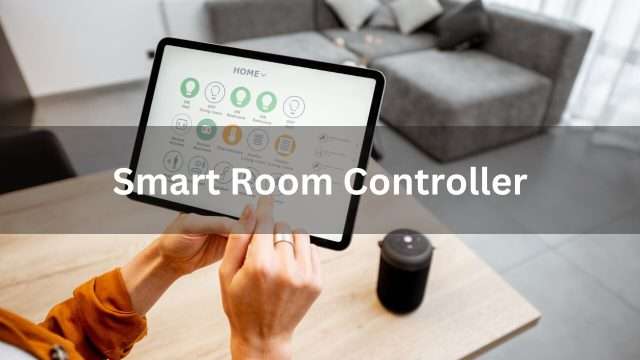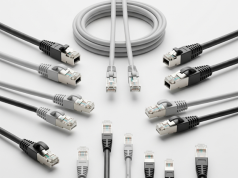Your intelligent room controller promises the perfect night’s sleep and the ideal lighting for any mood. But what if those features turned against you? We’re diving into the Top 6 Features of Smart Room Controllers in 2024, but with a twist. Are these features helpful, or could they create a technological nightmare? Buckle up and get ready to explore the cool features of intelligent room controllers, but also see how they might take a spooky turn!
Table of Contents
What is an intelligent room controller?
An intelligent room controller is a device that automates features in a room, like lights, temperature, and sometimes even access control. They might be found in homes, but they are more common in hotel rooms.
What are the features of an intelligent room controller device?
An intelligent room controller is the brain of a technologically advanced room. It is a central hub for automating various features and creating a comfortable, convenient environment. Here’s a breakdown of its functions:
- Temperature control
When it comes to temperature control, intelligent room controllers offer several features:
- Remote control: Adjust the room temperature from anywhere using the controller interface (touchscreen or app) – perfect for pre-heating the room before you arrive or turning down the heat before bed.
- Scheduling: Program the thermostat to automatically adjust throughout the day or week. For example, have it cool down at night for better sleep or warm up before you wake up.
- Learning: Some controllers can learn your preferences and adjust the temperature accordingly. This can help optimize comfort and energy efficiency.
- Integration with Sensors: They can work with motion sensors to adjust the temperature based on occupancy, such as automatically lowering the temperature when no one is in the room.
- Multiple Zone Control (advanced): In larger spaces, some controllers can independently manage the temperature in different zones, providing personalized comfort for each area.

- Light dimmer/on/off switch
Smart room controllers with light control offer a significant upgrade over traditional on/off switches. Here’s what you can expect:
- Dimming: Adjust the brightness of the lights to create the perfect ambiance. Want a bright work environment? Crank them up. Are you setting the mood for a movie night? Dim them down for a cozy atmosphere.
- On/Off Control: Turn lights on and off remotely through the controller interface or app. No more scrambling to find the switch in the dark!
- Scheduling: Program lights to turn on at sunrise or sunset, mimicking natural light patterns. You can also set them to turn off automatically after a certain period of inactivity.
- Scene Creation: Combine light settings with other features (temperature, blinds) to create customized scenes. Imagine a “Movie Night” scene that dims the lights, lowers the temperature, and closes the blinds.
- Voice Control (with compatible systems): In some setups, you can control lights with voice commands through smart speakers like Amazon Alexa or Google Assistant.
- Window blind control
Not all intelligent room controllers include window blind control, but they offer luxury and convenience for those that do. Here’s how it works:
- Remote Control: Open, close, or adjust the tilt of your blinds directly from the controller interface or app. No more manually fiddling with cords or chains.
- Scheduling: Set schedules for blinds to open or close automatically at specific times. Imagine waking up to natural light by programming the blinds to open at sunrise.
- Integration with Sensors (advanced): Some controllers can work with light sensors to adjust blinds based on sunlight intensity. For example, they automatically close them during the afternoon to keep the room cool.
- Scene Creation: Combine blind control with other features (lights, temperature) to create customized scenes. Imagine a “Morning Routine” scene that opens the blinds, turns on lights, and adjusts the temperature for a refreshing start to your day.
- Alarm clock Control
Smart room controllers with alarm clock control are less standard than the other features, but they can offer a convenient way to manage your wake-up routine. Here’s what you might find:
- Integrated Alarm: Set and manage alarms directly through the controller interface or app. There is no need for a separate alarm clock on your nightstand.
- Multiple Alarms: Program multiple alarms for different times or days.
- Customizable Sounds: Choose from various alarm sounds or even nature sounds for a more gentle wake-up experience.
- Scene Creation (advanced): Some systems combine the alarm with other features like light control. Imagine an alarm that gradually increases the light intensity in the room before the alarm sounds, simulating a sunrise and easing you awake more naturally.
- TV controller
While not all intelligent room controllers include TV control, some offer this functionality. Here’s what you can expect if your controller has TV integration:
- Primary Control: Similar to a traditional remote, this function allows you to turn the TV on and off, adjust the volume, and change channels. However, this is done through the controller interface or app, eliminating the need for a separate remote.
- Source Selection: Switch between input sources like HDMI, cable, or streaming services.
- Advanced Features (limited): Some controllers might offer limited advanced features like channel browsing guides or basic playback controls (play, pause, rewind). However, you might still need the original TV remote for more in-depth control of streaming apps or smart TV functionalities.
TV control features in smart room controllers might be more essential than those in dedicated remotes or smartphone apps designed specifically for the TV.
- Bedside communication to the front desk
There are a few ways you can communicate with the front desk from your bedside, depending on the hotel’s setup:
- Phone: This is the most universal method. Most hotel rooms will have a phone with a dedicated button for the front desk.
- In-room Tablet/Controller: Some hotels provide tablets or controllers in the room that allow you to access various features, including contacting the front desk through a messaging app or a virtual call option.
- Voice Assistant (advanced): In some modern hotels, you might be able to use a voice assistant device like Amazon Alexa or Google Assistant to ask the front desk for more towels with voice commands (e.g., “Alexa, ask the front desk for more towels”).
- Hotel App (if available): A few hotels have mobile apps allowing guests to communicate with the front desk through messages or chat.
Benefits of a room controller
Smart room controllers offer a range of benefits for both users (hotel guests or homeowners) and the establishments managing the rooms. Here’s a breakdown:
Cost & energy savings
The cost of an intelligent room controller can vary greatly depending on several factors:
- Features: Controllers with more features (window blind control, TV control, etc.) will generally cost more than basic models with lighting and temperature control.
- Brand & Quality: Well-known brands and controllers with higher build quality are more expensive.
- Commercial vs. Residential: Controllers designed for commercial use in hotels might be more expensive due to their durability and additional functionalities.
Here’s a rough idea of the price range:
- Primary Controllers: $50 – $150 (Simple lighting and temperature control)
- Mid-Range Controllers: $150 – $500 (Additional features like blind control, scheduling)
- Advanced Controllers: $500+ (Extensive features, integration with multiple smart home devices)
Energy Savings:
Smart room controllers can potentially lead to energy savings through features like:
- Automated Temperature Control: Scheduling the thermostat to adjust automatically based on occupancy or time of day can prevent unnecessary heating or cooling.
- Lighting Control: Dimming lights or scheduling them to turn off automatically reduces energy consumption compared to leaving them on constantly.
However, the actual energy savings will depend on various factors such as:
- Usage Habits: How often do you adjust the temperature or lights manually?
- Climate: Energy savings from temperature control will be more significant in extreme-estimate regions.
- The efficiency of Existing Systems: Smart controls can only optimize what’s already there. If your heating/cooling system or lighting fixtures could be more efficient, the impact might be minimal.
While energy savings might not immediately offset the cost of the controller itself, it can contribute to overall energy efficiency in the long run, especially when combined with other smart home practices.
Ease of use
The ease of use of an intelligent room controller depends on several factors:
- Interface: The best controllers have user-friendly interfaces, often featuring:
- Touchscreens are intuitive and easy to navigate, like a smartphone or tablet.
- Clear Icons and Labels: Labels should be easy to understand, with clear visuals for different functions.
- Simple Navigation: The layout should be logical and allow quick access to desired features.
- App Integration (if applicable): Some controllers work with a smartphone app. A good app will be:
- Well-designed: Similar to the controller interface, the app should be easy to navigate and understand.
- Intuitive controls: Functions should be represented within the app.
- Minimal setup: The app should connect to the controller easily with minimal configuration.
- Learning Curve: Most modern, bright room controllers are designed to be user-friendly, even for those unfamiliar with technology. However, some advanced features or complex layouts require a short learning curve.
Here’s a breakdown of ease of use for different user groups:
- Tech-Savvy Users: These users will likely find most controllers intuitive and easy to pick up.
- Less Tech-Savvy Users: Simple interfaces with clear labels and basic features will be easier to learn and use. Opt for controllers with physical buttons alongside touchscreens for a more familiar feel.
- Hotels: Most hotel room controllers are designed for ease of use by guests with varying levels of tech experience. They often prioritize clear icons and essential functions for standard adjustments (lights, temperature).
Overall, intelligent room controllers are becoming increasingly user-friendly. Look for models with intuitive interfaces and well-designed apps (if applicable), and consider your comfort level with technology when choosing.
Endless customization potential
You’re right! Endless customization potential is a significant advantage of intelligent room controllers, especially in a home setting. Here’s how they allow you to personalize your environment to a high degree:
- Granular Control: Adjust lighting beyond simple on/off. Set the perfect ambiance with dimming features, color temperature control (warm white to cool white), or even pre-programmed lighting scenes.
- Temperature Zoning (advanced): Some controllers allow you to manage temperature in different zones in larger homes independently. This is perfect for keeping the bedroom cooler at night while maintaining a comfortable temperature in the living room.
- Scheduling: Automate features based on your preferences and daily routines. Lights can automatically dim in the evening, the thermostat can adjust for sleep time, or blinds can open gradually to mimic sunrise.
- Scene Creation: Combine adjustments to lighting, temperature, and blinds (if applicable) with a single command to create customized ambiances. Imagine a “Movie Night” scene that dims the lights, lowers the temperature, closes the blinds, and even turns on your smart TV (if integrated).
- Integration with Other Smart Devices: Many controllers work with various smart home devices, allowing you to create even more complex automation. Imagine lights automatically adjusting based on motion sensor detection or blinds closing when the room temperature reaches a certain level.
This level of customization allows you to truly personalize your living space to suit your needs and preferences. Whether you crave a relaxing spa-like atmosphere in the bathroom, a bright and productive workspace in your home office, or a cozy movie night setting in the living room, smart room controllers can help you achieve it with a few taps or voice commands.
Highly connective
You’re on point! High connectivity is another key strength of smart room controllers, particularly in the context of smart homes. Here’s how they excel in connecting various devices and creating a unified system:
- Central Hub: The controller acts as a central hub, allowing communication between various smart home devices within the room (lights, thermostats, blinds, etc.). This eliminates the need for individual apps or remotes for each device.
- Standardized Protocols: Most controllers use protocols like Zigbee or Z-Wave to communicate with other smart devices, ensuring compatibility with various brands and products.
- Seamless Integration: Imagine adjusting the lights, temperature, and blinds with a single command or creating automated scenes that trigger these devices. A highly connective controller makes this possible.
- Voice Control Integration (advanced): Some controllers work with smart speakers like Amazon Alexa or Google Assistant. This allows you to control various devices in the room with voice commands, offering a hands-free experience.
- Future potential: As smart home technology evolves, highly connective controllers will play an even more significant role in seamlessly integrating new devices and functionalities into your living space.
This connectivity fosters a more streamlined and convenient smart home experience. Imagine entering a room and automatically adjusting the lights based on the time of day or setting a “Good Morning” scene that adjusts the temperature, opens blinds, and starts your coffee maker with a single voice command or through the controller interface. Smart room controllers act as the brains of your smart home, connecting the dots and creating a genuinely automated and personalized living environment.
Improved comfort
Smart room controllers contribute to improved comfort in several ways:
- Personalized Environment: They allow you to adjust lighting and temperature, sometimes even blinds to your preferences. Imagine setting the lights to a warm, relaxing glow for a bath or cranking them up for a productive work session. Adjust the temperature for a perfectly comfortable sleep or a refreshing wake-up experience.
- Automation for Convenience: Scheduling features like lights and thermostats to adjust automatically eliminates the need for constant manual adjustments. Walk into a pre-heated room in the winter or have the lights dim automatically as evening approaches, enhancing comfort without any effort.
- Scene Creation: Combine adjustments to lighting, temperature, and blinds (if applicable) with a single command to create customized comfort settings. Imagine a “Movie Night” scene that dims the lights, lowers the temperature, and closes the blinds, creating a perfectly relaxed atmosphere.
- Improved Sleep: Features like automated light-dimming routines and temperature adjustments for sleep can contribute to a better night’s rest.
- Accessibility (in some cases): Some controllers might integrate with smart home devices like voice assistants or smart thermostats with voice control, allowing for hands-free adjustments, which can be helpful for people with limited mobility.
Smart room controllers can significantly enhance your experience in a room, whether at home or in a hotel, by offering personalized control, convenient automation, and the ability to create customized comfort settings.
How to use an intelligent room controller?
Using an intelligent room controller will vary depending on the specific model and interface, but here’s a general breakdown of the process:
Basic Functionality:
- Power Up: Most controllers are either directly wired or battery-powered. Ensure it’s properly connected or charged.
- Interface: You’ll interact with the controller through a touchscreen panel or a dedicated app (sometimes both).
- Lighting: Look for buttons or sliders to adjust brightness and potentially color temperature (if available).
- Temperature: Locate the thermostat controls to adjust the desired temperature. Some might offer scheduling options.
- Optional Features: If your controller has features like blind control or an alarm clock, explore the dedicated sections of the interface or app to manage those settings.
Advanced Features (if applicable):
- Scene Creation: Some controllers allow you to create customized scenes that combine adjustments to lighting, temperature, and blinds (if applicable) with a single command. Explore the scene creation options in the interface or app.
- Voice Control Integration (advanced): If your controller works with smart speakers, learn to use voice commands to control features like lights or temperature. For specific commands, refer to the controller’s manual or app instructions.
- App Integration (if applicable): Download and install the dedicated app for your controller. The app should guide you through the connection process and allow you to control features remotely (if supported).
General Tips:
- Consult the Manual: Every controller has a user manual that explains its specific features and functionalities. The manual provides detailed instructions and troubleshooting tips.
- Start Simple: Don’t overwhelm yourself with advanced features at first. Start by exploring the basic controls for lighting and temperature to get comfortable with the interface.
- Experiment: Once familiar with the basics, experiment with scheduling features and scene creation (if applicable) and explore advanced functionalities to personalize your experience.

Remember, most smart room controllers are designed to be user-friendly. If you need help, consult the manual, search online for tutorials specific to your model, or contact the manufacturer’s customer support.
You can also read: Titanium Vs Stainless
Conclusion
Smart room controllers offer a glimpse into the future of personalized comfort and convenience. From adjusting the temperature to creating customized lighting scenes, they promise to enhance our living experiences. However, as with any new technology, there are potential downsides. Security vulnerabilities and the risk of malfunction could turn these helpful tools into a source of frustration or even fear.
The Choice is Yours
Understanding smart room controllers’ potential benefits and drawbacks empowers you to make informed decisions. Do you crave the comfort and convenience they offer? Or do the potential security risks give you pause? Ultimately, the choice is yours. But one thing is sure: the world of smart homes is rapidly evolving, and intelligent room controllers are poised to play a significant role in shaping our living spaces of tomorrow.
Stay Tuned!
As smart home technology continues to develop, we can expect even more advanced features and functionalities from smart room controllers. Here at spoxor.com, we’ll keep you updated on the latest advancements and innovations in this exciting field. So, stay tuned for future blog posts exploring the ever-evolving world of smart home technology!







